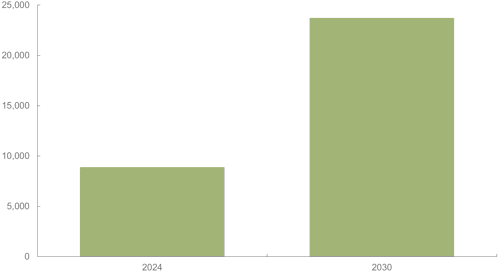Q-Day: The Race to Secure Satellite Connectivity
Driven by the prospect of being connected no matter where on Earth you are, the satellite IoT market has grown. In particular, the introduction of LEO (Low-Earth Orbit) satellites has pushed this growth, with faster development and lower costs to both develop and launch compared to traditional satellites. LEO satellites are expected to grow by 166% globally by 2030, as seen in the figure below:
Number of LEO Satellites in Service, 2024 vs 2030

Source: Juniper Research
However, the growing threat of cyberattacks continues to remain a large issue within this market. As satellites have numerous access points through ground stations, the satellites themselves and IoT devices, monitoring and defending satellite communications against cyberattacks can be difficult, with some unauthorised entries into the network hard to trace, and some even going undetected.
In order to protect data against cyberthreats, satellite network operators have to ensure that they use advanced encryption algorithms. One of the ways in which to create an almost hack-proof defence is through the use of quantum cryptography, particularly methods such as QKD (Quantum Key Distribution). QKD uses the random state of quantum particles, such as photons, to share keys between two parties. This method is considered hack-proof because of its ability to send alerts if a key is tampered with by a third party. Any third-party interference with the key will result in the photons changing their state, which will send an alert to the sender that a new key needs to be distributed.
However, the development of quantum computing has caused deep unrest in the cybersecurity industry because of their ability to solve complex algorithms in a much shorter time frame than classical computers. In the hands of bad actors, this will mean that any advanced encryption algorithms used to protect data, including QKD, could be broken in a matter of days, leaving companies and the public incredibly vulnerable.
As we enter a post-quantum phase, operators are looking for the best possible defence to keep data safe from attacks not only from classical computers, but from quantum computers as well. This has resulted in a race to develop quantum-safe cryptography or post-quantum cryptography before what has been dubbed as Q-day – the day that quantum computers will be able to break public encryption systems. With the development of quantum computing via key players such as Google and IBM, this may be coming sooner than we expect.
So, how do we prepare for Q-day?
The use of AI and machine learning will prove vital in the development and optimisation of post-quantum encryption algorithms. These algorithms use advanced mathematical problems to ensure that they are quantum resilient. However, these algorithms may also become vulnerable to quantum attacks in the future. Machine learning and AI can help detect the best algorithm for a situation and swap algorithms to help protect against attacks. They can also aid in threat and anomaly detection, one of the first lines of defence in cybersecurity. Machine learning algorithms can be trained to analyse large amounts of data in real-time, triggering an alert if an anomaly or threat is detected.
As the satellite IoT services market continues to grow, operators have a responsibility to protecting their uses against these attacks. Investing in advanced cybersecurity practices such as post-quantum cryptography will become a necessity. Partnering with cybersecurity firms will also prove beneficial, as Starlink, a satellite Internet constellation, and Qusecure, a provider of quantum security solutions, have recently announced the development of the first quantum-resilient satellite; using post-quantum cryptography. As cyberattacks will forever evolve, cybersecurity will have to evolve with them. In order to keep data as safe as possible and mitigate attacks, operators must always develop, monitor and test their solutions, as well as remaining vigilant to the current landscape of cybersecurity.
As a Research Analyst within Juniper Research's IoT & Emerging Technology team, Michelle provides insight and analysis on the latest developments in nascent, fast-growing technology markets. Her latest reports include Smart Buildings and Satellite IoT.
Latest research, whitepapers & press releases
-
 ReportDecember 2025
ReportDecember 2025AI Agents for Customer Experience Platforms Market: 2025-2030
Our comprehensive AI Agents for Customer Experience Platforms research suite comprises detailed assessment of a market that is set to disrupt mobile communications. It provides stakeholders with insight into the key opportunities within the AI agents for customer experience platforms market over the next two years.
VIEW -
 ReportDecember 2025Fintech & Payments
ReportDecember 2025Fintech & PaymentseCommerce Fraud Prevention Market: 2025-2030
Our eCommerce Fraud Prevention research suite provides a detailed and insightful analysis of this evolving market; enabling stakeholders from financial institutions, law enforcement agencies, regulatory bodies and technology vendors to understand future growth, key trends, and the competitive environment.
VIEW -
 ReportNovember 2025Telecoms & Connectivity
ReportNovember 2025Telecoms & ConnectivityeSIMs & iSIMs Market: 2025-2030
Juniper Research’s eSIMs and iSIMs research suite offers insightful analysis of a market set to experience significant growth in the next five years. The research suite provides mobile network operators (MNOs), original equipment manufacturers (OEMs), and eSIM management and platforms vendors with intelligence on how to capitalise on the market growth, and guidance on how eSIM-only devices and sensors, SGP.42, in-factory provisioning, and iSIMs will change the competitive landscape.
VIEW -
 ReportNovember 2025Fintech & Payments
ReportNovember 2025Fintech & PaymentsModern Card Issuing Platforms Market: 2025-2030
Our Modern Card Issuing Platforms Market research suite provides a detailed and insightful analysis of this evolving market; enabling stakeholders from banks, financial institutions, fintech companies, and technology vendors to understand future growth, key trends, and the competitive environment.
VIEW -
 ReportNovember 2025Fintech & Payments
ReportNovember 2025Fintech & PaymentsDigital Wallets Market: 2025-2030
Our digital wallets research suite provides detailed analysis of this rapidly changing market; allowing digital wallet providers to gain an understanding of key payment trends and challenges, potential growth opportunities, and the competitive environment.
VIEW -
 ReportOctober 2025Fintech & Payments
ReportOctober 2025Fintech & PaymentsDigital Identity Market: 2025-2030
Juniper Research’s Digital Identity research suite provides a comprehensive and insightful analysis of this market; enabling stakeholders, including digital identity platform providers, digital identity verification providers, government agencies, banks, and many others, to understand future growth, key trends, and the competitive environment.
VIEW
-
 WhitepaperDecember 2025Telecoms & Connectivity
WhitepaperDecember 2025Telecoms & ConnectivityHuman + AI: Drivers of Customer Experience AI Agents in 2026
Our complimentary whitepaper, Human + AI: Drivers of Customer Experience AI Agents in 2026, examines the key drivers of the AI agents for customer experience platforms market in 2025.
VIEW -
 WhitepaperDecember 2025Fintech & Payments
WhitepaperDecember 2025Fintech & PaymentsBeyond Chargebacks: The True Cost of Fraud for Digital Commerce
Our complimentary whitepaper, Beyond Chargebacks: The True Cost of Fraud for Digital Commerce, examines the state of the eCommerce fraud prevention market; considering the impact of evolving digital fraud strategies, including key trends such as identity theft, account takeovers, chargebacks, policy abuse and friendly fraud.
VIEW -
 WhitepaperNovember 2025Telecoms & Connectivity
WhitepaperNovember 2025Telecoms & ConnectivityeSIM-only Devices: The Impact on Operators, Consumers, and IoT
Our complimentary whitepaper, eSIM-only Devices: The Impact on Operators, Consumers, and IoT, explores the challenges and opportunities for the three segments, with a particular focus on eSIM-only smartphones and SGP.42.
VIEW -
 WhitepaperNovember 2025Fintech & Payments
WhitepaperNovember 2025Fintech & PaymentsUnlocking the Next Stage of Growth for Modern Card Issuing Platforms
This free whitepaper analyses key trends shaping the modern card issuing space, and the ways in which modern card issuing platforms can capture growth.
VIEW -
 WhitepaperNovember 2025Fintech & Payments
WhitepaperNovember 2025Fintech & PaymentsTop 10 Fintech & Payments Trends 2026
Fintech is evolving fast. From stablecoins to agentic AI, our annual guide reveals the shifts redefining payments, digital identity, and the future of money in 2026. Download your copy today.
VIEW -
 WhitepaperNovember 2025Fintech & Payments
WhitepaperNovember 2025Fintech & PaymentsDigital Wallets: Empowering Financial Inclusivity
Our complimentary whitepaper, Digital Wallets: Empowering Financial Inclusivity, examines the state of the digital wallets market; considering the impact of digital wallets on different geographies, how they are shaping the modern payments landscape through lower transaction fees and promoting financial inclusivity for underbanked populations, and how they are competing with established payment methods.
VIEW
-
IoT & Emerging Technology
Juniper Research Unveils Top 10 Emerging Tech Trends to Watch in 2026
January 2026 -
Fintech & Payments
Digital Identity App Usage to Hit 6.2 Billion by 2030, Driven by Shift to Decentralised Models
December 2025 -
Telecoms & Connectivity
Travel eSIM Margins Under Pressure as Revenue per Gigabyte Falls 10% Globally in Two Years
December 2025 -
Telecoms & Connectivity
AI Agents to Power 1,000% More Customer Interactions for Enterprises Globally by 2027
December 2025 -
IoT & Emerging Technology
Global D2C Revenue Set for $370 Million Surge, But Satellite Operators Should Not Chase Full MNO Status
December 2025 -
Fintech & Payments
Digital Goods Fraud to Cost eCommerce Merchants $27 Billion Globally by 2030 as AI Tools Accelerate Attacks
December 2025





















